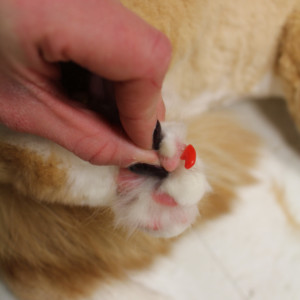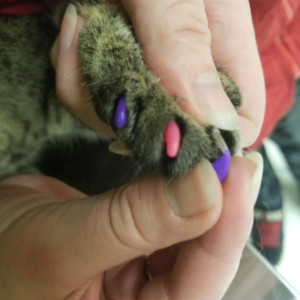Cat owners often seek solutions to curb scratching, and Toenail Covers For Cats have emerged as a popular option. However, misconceptions surrounding their safety and comfort can make owners hesitant. Let’s debunk some common myths about toenail covers, also known as nail caps, and explore the facts.
Myth 1: Toenail Covers Prevent Cats From Retracting Their Claws
This is completely false. A cat’s claw retraction is a natural movement, and toenail covers are designed to accommodate it. When a cat relaxes, their claws retract to prevent contact with the ground while walking. Toenail covers, when properly applied and sized, do not hinder this mechanism. The cat’s claws can extend and retract naturally, just as they would without the covers. Proper application is key, ensuring the right size for the nail, trimming the nail appropriately before application, and using only enough adhesive to secure the cover.
Myth 2: Toenail Covers Damage the Nail or Nail Bed
 Close-up of cat paw showing toenail covers, demonstrating how they do not interfere with natural nail retraction.
Close-up of cat paw showing toenail covers, demonstrating how they do not interfere with natural nail retraction.
High-quality toenail cover brands, like Soft Paws, were developed by veterinarians with cat safety in mind. These covers are made from soft, non-toxic materials, ensuring they are safe for both cats and dogs. When applied correctly, toenail covers should not cause any damage or discomfort to the cat’s paws or nail beds. Correct application involves several important steps:
- Proper Sizing: Choosing the correct size of toenail cover to comfortably fit each of your cat’s nails is crucial.
- Appropriate Adhesive Use: Using enough glue to ensure adhesion, but avoiding excess that could overflow during application, is essential. The adhesive should only contact the nail itself and must not touch the cat’s fur, nail bed, or surrounding skin.
- Correct Nail Trimming: Nails should be trimmed slightly longer than a typical nail trim, just past the hook’s tip, ensuring there is space between the toenail cover and the cat’s nail bed.
Myth 3: Scratching Posts Are Enough, Making Toenail Covers Unnecessary
Scratching posts are indeed beneficial for cats. They encourage stretching and flexing, offer a designated scratching outlet instead of furniture, and allow cats to mark their territory with their paw scent. However, the idea that scratching posts “file down” a cat’s nails to dullness is a common misunderstanding. Scratching posts primarily help cats shed the dead outer layers of their nail sheaths, revealing sharper, new nails underneath. Therefore, while scratching posts are vital for nail health, they don’t eliminate sharpness and potential scratching damage.
Regular toenail cover application, preceded by nail trimming to remove dead nail sheath layers and shorten the nails, addresses this. Since toenail covers should be replaced regularly, ideally every 4-6 weeks and no longer than 6-8 weeks, this process maintains nail health and appropriate length. It effectively prevents scratching damage while still allowing cats to engage in their natural stretching, flexing, and scratching behaviors.
Myth 4: Toenail Covers Don’t Stay On For Long
 Example of cat toenail covers applied to cat claws, highlighting their comfortable and secure fit.
Example of cat toenail covers applied to cat claws, highlighting their comfortable and secure fit.
Initially, some cats might notice the toenail covers and attempt to bite or remove them. This is a normal reaction and usually subsides within a few weeks or after a few applications. Most cats adapt quickly and ignore them. Positive reinforcement techniques, such as offering treats, engaging in play, and providing cuddles, can effectively distract cats from picking at the covers. These methods also help create a calmer experience during nail trimming and toenail cover application.
Myth 5: Toenail Covers Are a Permanent Fix
Toenail covers are not designed to halt natural nail growth. Cat nails continue to grow at their normal rate even with covers on, and if left for too long, nails can grow uncomfortably long underneath. Even if your cat seems to tolerate the initial application well, toenail covers should not be left on for longer than 6-8 weeks. After this period, the remaining covers should be removed using nail trimmers. It’s essential to trim and clean the nails before applying a fresh set of toenail covers. This routine maintains nail health and appropriate length, providing consistent scratch protection.
Who Can Benefit From Toenail Covers?
Toenail covers can be a great solution for many cats and owners in various situations:
- Owners with delicate skin: Elderly individuals or those with thin skin or bleeding disorders due to medications or health conditions.
- Families with young children: Households with small children or frequent visits from family and friends.
- Protecting home furnishings: Homes with antique furniture, delicate quilts, rugs, and other valuables.
- Cats with behavioral issues: Cats or kittens who tend to play roughly or exhibit aggressive scratching behaviors.
- Cats with skin conditions: Cats with skin issues, chronic itching, or health problems that exacerbate scratching.
- Hairless breeds: Sphynx and other hairless cats with sensitive skin prone to scratching injuries.
- Cats prone to snagging claws: Cats whose nails frequently get stuck in carpets, bedding, clothing, or other fabrics.
When Toenail Covers Might Not Be Suitable:
However, toenail covers are not always the best choice for every cat and owner:
- Outdoor cats: Cats that spend time outdoors might find toenail covers less practical or potentially hazardous in outdoor environments.
- Owners with time constraints: Owners unable to commit to a consistent 4-6 week nail trimming and toenail cover replacement schedule.
- Persistent removal behavior: Cats who continually bite or remove toenail covers even after several attempts and adjustments.
Toenail covers can be a helpful tool for managing cat scratching when used correctly and responsibly. Understanding the facts and debunking the myths allows cat owners to make informed decisions about their pet’s care and their household needs.

